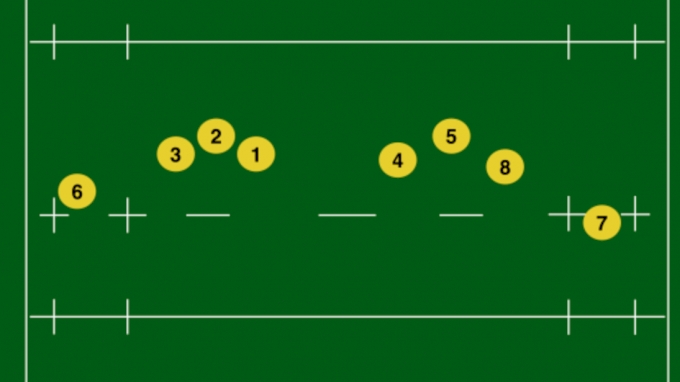Rugby Formations: 1-3-3-1 vs 2-4-2
Rugby Formations: 1-3-3-1 vs 2-4-2
Taking a look at two of the most common formations you'll see on a rugby field: the 1-3-3-1, and the 2-4-2.

In a rugby match, you won't see the typical "formations" that you see on the gridiron during a football game since the flow of the game is continuous, and there aren't many breaks in play. However, there are general patterns that teams like to run, which more or less distribute the forwards around the field in groups of one to four.
The two most common patters you'll see in 2020 are the 1-3-3-1 and the 2-4-2, which refer to how the eight forwards on the team are spread out throughout the pitch. In a 1-3-3-1, there will be one forward by each sideline, with two pods of three in the middle of the field. In the 2-4-2, there will be two groups of two forwards on the outsides of the field, with one group of four in the middle.
Here is a quick breakdown on each attack pattern and what advantages they offer:
The 2-4-2
The 2-4-2 will generally take a few phases after a set piece to set up, but once set up it provides your team the opportunity to spread the field and play the ball into space more. On each side of the field, in the 15 meter channels, a winger will line up with a hooker and a flanker, while the opposite winger will line up in a pod with the eight man and the other flanker. This provides the team with two pods of three on the outsides, with both power and speed included.
The two props and the two locks will be in a "working" pod in the middle of the field. In the two spaces between the three groups of pods, the fly-half and usually one of the centers will fill in and work as a link man to distribute.
The forwards don't have to work quite as much off the ball, since it finds them through passing rather than them finding the ball by running long distances. It also allows for better ball security, considering that the players will almost always be in groups of at least three -- as long as the link players don't get caught isolated.
One of the key advantages to the 2-4-2 is that it helps the forwards to have more room when they get the ball to make things happen, rather than simply catch and run. It takes a more skilled, and more athletic forward pack on the whole to make it work, but it can do wonders if executed properly.
The 1-3-3-1
The 1-3-3-1 is used more frequently than the 2-4-2, but it has many of the same principles. The idea is to stress the defense by forcing it to cover a wide area of the field against both power and pace. The optimal result is to tie in defenders to the middle of the field, opening up space for the backs out wide.
Here is a look at the general shape of the pattern:

In the middle of the field, your two pods of three work in a sort of "V" formation, typically with backline player standing a bit deeper and directly behind the middle man in the pod. This gives the receiver the option to run the ball, pop it short, or throw it out the back to the backline player.
It is effective in punching holes in the middle of the field, generating quick ball, and keeping options open to the right and to the left. In the outer channels, the two flankers are there to operate as strong ball carriers and also as good breakdown specialists to tidy up clean ball.
The forwards do have to work a bit to get to and from the breakdowns, but their jobs when they get the ball are straight forward enough. In the 1-3-3-1, it is never going to be a wrong option to simply just take the carry and reset. The shape is easy enough to get back into, and anyone can fill any position on the field.
For an excellent breakdown of the shape, check out this video from The 1014 Rugby: